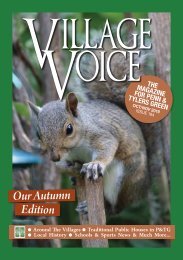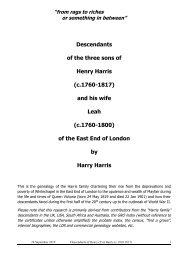Village Voice Oct / Nov 2017 Issue 182
You also want an ePaper? Increase the reach of your titles
YUMPU automatically turns print PDFs into web optimized ePapers that Google loves.
<strong>Village</strong> <strong>Voice</strong> <strong>Oct</strong>ober/<strong>Nov</strong>ember <strong>2017</strong><br />
THE HISTORY OF<br />
ASHWELLS (GOMM)<br />
VALLEY (PART 11)...<br />
Professor William Rose (1847-1910)<br />
We have seen<br />
that Professor<br />
William Rose,<br />
first cousin of<br />
the second Sir<br />
Philip Rose of<br />
Rayners, had<br />
bought<br />
Ashwells<br />
farmhouse<br />
with 58 acres<br />
from Lord<br />
Carrington in<br />
1902 and<br />
built the<br />
attractive Edwardian country house which we<br />
have known for many years as the Kathleen<br />
Knapp Home, but is now the focus of the new<br />
development called Ashwells Gardens. He even<br />
had electric light - probably the only house in<br />
Tylers Green to have it.<br />
We can, for the first time, say something<br />
about the character and personality of the<br />
occupant of Ashwells. There is a very full<br />
account of Professor Rose's life in an obituary<br />
compiled for the Royal College of Surgeons .<br />
Like his father, who was the leading surgeon in<br />
High Wycombe, he was a well-known surgeon<br />
and served for 25 years at King's College<br />
Hospital in London where he was eventually<br />
made Emeritus Professor. He was described as<br />
having 'a wonderful dexterity' which made it a<br />
great pleasure to watch him operating. He<br />
co-wrote a popular textbook on surgery as well<br />
writing many articles for medical journals.<br />
He loved horses and was constantly seen<br />
driving his four-in-hand and is said to have had<br />
a window made at the end of his hall through<br />
which he could see his beloved horses. His<br />
hospitality was boundless and his dinners for his<br />
medical staff were grand events in their lives.<br />
He was musical, played the drums, had a keen<br />
sense of humour, told a good story and had an<br />
infectious and loud laugh. At his country house<br />
in Penn he dispensed hospitality and 'was much<br />
beloved by his poorer neighbours whom he<br />
charitably benefitted by his surgical skill and<br />
experience'.<br />
The opening of the 'Beaconsfield for Penn'<br />
station on the Marylebone railway in 1906<br />
attracted several distinguished doctors to live in<br />
Penn, but Dr William Rose was here because his<br />
family were already living in Tylers Green. The<br />
second Sir Philip Rose was at Rayners and<br />
owned much of the village, and his nearest<br />
neighbour was another cousin, Sir Philip's<br />
younger brother, Bateman Lancaster Rose, who<br />
moved into the adjoining White House in<br />
Church Road in 1903. The three leading<br />
32 www.pennandtylersgreen.org.uk

















